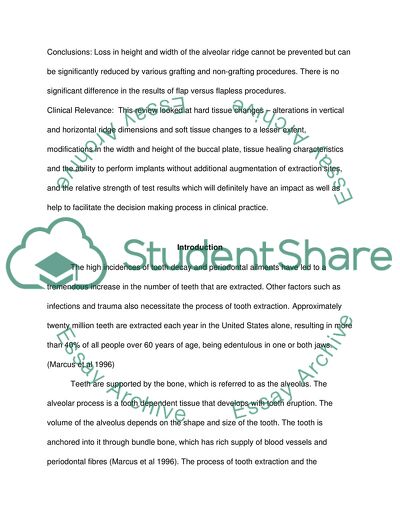
- Home
- Free Samples
- Premium Essays
- Editing Services
- Extra Tools
- Essay Writing Help
- About Us
- Studentshare
- Subjects
- Health Sciences & Medicine
- Bone Resorption Following Tooth Extraction in Grafted Sockets vs Non-Grafted Sockets
Bone Resorption Following Tooth Extraction in Grafted Sockets vs Non-Grafted Sockets - Coursework Example

- Subject: Health Sciences & Medicine
- Type: Coursework
- Level: Undergraduate
- Pages: 25 (6250 words)
- Downloads: 0
- Author: dejuan20
Extract of sample "Bone Resorption Following Tooth Extraction in Grafted Sockets vs Non-Grafted Sockets"
The articles were selected according to various inclusion and exclusion criteria. Studies that reported dimensional changes in alveolar height and width within 12 months of extraction were selected.Results: Nine studies were identified as satisfying the stated inclusion criteria. Statistically significant changes in dimensions were observed when various grafting and non-grafting procedures were compared. The average change ranged from 0.09 to 4.4mm. While grafting techniques resulted in a statistically significant reduction in bone absorption, others showed statistically insignificant differences. In some cases, the changes in the vertical dimension were statistically significant while the changes in the horizontal dimension were not and vice versa.
It was not possible to conclude which grafting procedure was superior. There were no significant changes in flap versus flapless procedures involving hard and soft tissue. However, more tests need to be carried out on soft tissue changes. Conclusions: Loss in height and width of the alveolar ridge cannot be prevented but can be significantly reduced by various grafting and non-grafting procedures. There is no significant difference in the results of flap versus flapless procedures. Clinical Relevance: This review looked at hard tissue changes – alterations in vertical and horizontal ridge dimensions and soft tissue changes to a lesser extent, modifications in the width and height of the buccal plate, tissue healing characteristics, and the ability to perform implants without additional augmentation of extraction sites, and the relative strength of test results which will have an impact as well as help to facilitate the decision-making process in clinical practice.
The high incidences of tooth decay and periodontal ailments have led to a tremendous increase in the number of teeth that are extracted. Other factors such as infections and trauma also necessitate the process of tooth extraction. Approximately twenty million teeth are extracted each year in the United States alone, resulting in more than 40% of all people over 60 years of age, being edentulous in one or both jaws.
...Download file to see next pages Read MoreCHECK THESE SAMPLES OF Bone Resorption Following Tooth Extraction in Grafted Sockets vs Non-Grafted Sockets
Networking and communication sys (sockets)
Gingival Tissue Grafts
Gingival Recession and Gingival Tissue Graft
Factors that would influence the decision-making process
Socket Programming - BSD UNIX by Bill Joy
Periodontal Ligament in Ensuring the Integrity of the Tooth
Dentistry Evaluation Of Single Unit Restoration Impressions
Digital Impressions from the Laboratory Technicians Perspective

- TERMS & CONDITIONS
- PRIVACY POLICY
- COOKIES POLICY